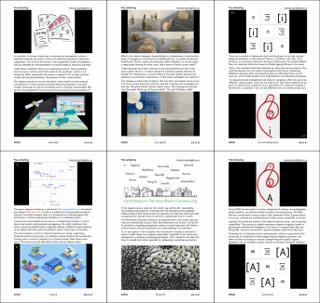#01-06 wheeling
Abstract
This flyer-series features the collection (X) as an intermediary between content (A) and container (B). That is, a triangular relationship as an alternative to our binary notion of content and container. ‘Wheeling’ determines when the container—from acting as a wrapper—starts acting as an axle of the content. Thereby collecting and multiplying the rolling capability of the compound.
Such turns are routine to designers, and a key to what they deliver to projects. However, routinely it may be, the principle is little understood. It harks back to the Renaissance and Giorgio Vasari’s idea of design as the animating principle of all creative process: placing design at the core of artistic practice—rather than its margins or outskirts—in a precinct headlined today as artistic research.
The instances that contribute to the dynamic turn—in the relation between content and container—may be multiple and distributed and, as such, constitute material for research and discussion. The turn itself, however, features as this material comes through as a collection (X). As a material it can be compared to a set of rollers used to move a heavy object. As a collection it turns into a wheel.
Gilbert Simondon understood the wheel as the application of the double application of the moving principle of a roller: at the rim and the hub—the latter constituting the axle of a wheel. Here the collection is understood as the multiplying (rim) and unifying (hub) principle of rotation. It gathers and distributes at the same time. The fascination of the collector as featured by Walter Benjamin.
What interests us here—beyond this enclosure—is, however, the dissipation of information that comes out of the collected instance (X) between the content (A) and container (B) considered as a concrete individual, or a communicating process of individuation. The compound, then, is “rolling”: whether the instance is concrete as individual (wheel) or communicative individuation (process).
This should allow us to distinguish snowballing dynamics from designed ones; which is what is ventured here. Whether we are considering snowballing in the are of statistic measurements, art projects the include administrative governance as aesthetic materials, critical thresholds in the hatching of group intelligence, slippery slopes of deregulation, environmental design, and money.
The present flyer collection, hopefully, manages to demonstrate and not only argue the point. The function of a 6-flyer set (a HEX) is to collect, and always relates to a case-base of contingent elements (touching each other as our day-to-day business regularly does). In this particular collection a proposition is made on the container as a coordinate entity to the content.
Description
Flyer set—#01 attempt; #02—try again; #03—do something else; #04—return; #05—unlearn; #06—crossover.

